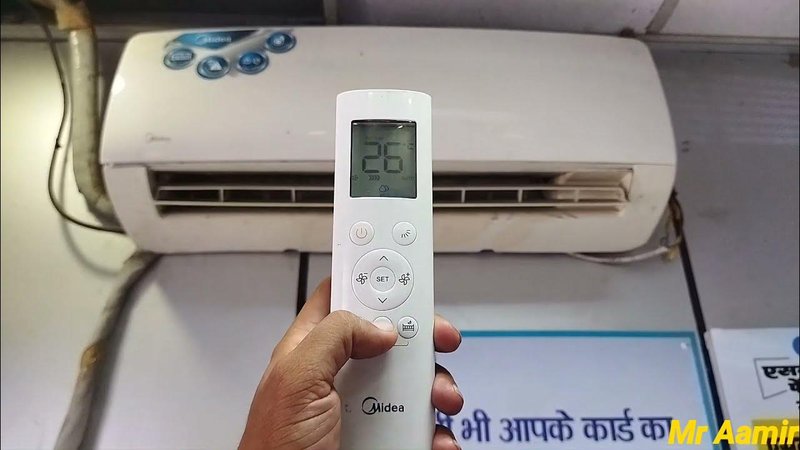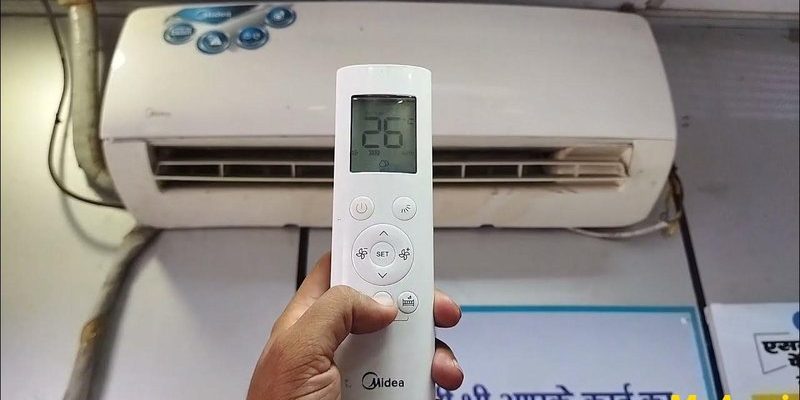
Here’s the thing: most of us just want our rooms comfortable. No wild temperature swings, no mysterious beeping, and definitely no remote-throwing meltdowns. But figuring out the right mode can feel strangely high stakes — like, “Will I wake up shivering at 3 a.m. if I pick the wrong setting?” If you’ve ever hesitated with your thumb hovering over the remote, you’re not alone. Midea is a super popular brand, and their remotes, whether you’ve got a split AC, a window unit, or a portable one, are all fairly similar. But those tiny symbols and cryptic words can make anyone second-guess.
Let’s walk through each remote mode, slowly and visually, so you can finally relax and press the right button — without needing an engineering degree or a call to customer service.
Getting to Know Your Midea AC Remote: The Basics
Before picking a mode, let’s just get super familiar with this remote in your hand. Most Midea AC remotes follow the same basic layout, with a big Mode button front and center. When you press it, you’ll notice the screen cycling through little icons: a snowflake, a droplet, a fan, the word “Auto,” and maybe even a crescent moon for “Sleep.” Each icon stands for a different mode, and I promise, it’s less mystical than it looks.
The remote’s display usually shows the temperature, fan speed, and sometimes an indicator for other settings like a timer or child lock. If yours isn’t showing anything, no shame — start by checking the battery. Honestly, I’ve wasted more time than I’d like to admit troubleshooting the “broken” AC, only to realize the remote had dead batteries.
Setting up your remote is as simple as popping in a fresh pair of batteries, and sometimes you’ll need to pair or sync it with the AC unit. If it’s brand-new, you might have to follow a “code” from the manual to make sure it communicates with your system. For most people, though, it’s ready to go right out of the package, and a simple reset (read: holding the “reset” or “power” button for a few seconds) fixes most tiny glitches.
Cool Mode: The Summer Savior
This is the one most folks gravitate to when things get muggy and you’re sweating through your t-shirt. The Cool mode, usually marked by a snowflake icon, tells your Midea AC to work just like you’d expect — turning on the compressor and cooling the room to your set temperature.
Here’s the magic: You pick your ideal temperature (let’s say, 24°C or 75°F), set the fan speed if you want, and the AC cycles on and off to keep it there. Think of it as your personal room butler, actively maintaining chill. Great for hot afternoons or when guests come over and you want everyone comfortable fast.
But — and there’s always a “but” — this mode uses the most power. If you’re watching your electric bill, just know that Cool mode is the AC equivalent of putting your car in sport mode. On the bright side, it’s the most predictable and quickest way to bring down the temperature without fussing around.
When friends come over for movie night and the room is packed, Cool mode is my go-to. The remote is my secret weapon to keep everyone comfy (and nobody even knows how much thought went into it!).
Dry Mode: Your Humidity Hero
You might be wondering, “What’s up with this raindrop icon?” That’s Dry mode, and it’s actually a game-changer, especially in places with sticky, humid weather. Instead of blasting cold air nonstop, the AC shifts focus to pulling moisture out of the air.
Here’s what’s interesting: In Dry mode, your Midea AC runs the fan and compressor in short bursts, mostly targeting humidity rather than drastically dropping the temperature. Imagine walking into a fresh laundry room — not icy, but just… crisp. If you live in a place where it’s warm but also sticky (looking at you, coastal cities), this mode cuts that heavy, uncomfortable feeling and helps you feel dry, not clammy.
Don’t expect Dry mode to cool the room like crazy — that’s not its job. But if you’ve ever felt like your skin’s glued to the furniture, give this a try. Also, it saves electricity compared to Cool mode, since the compressor’s not running all the time. That’s a sneaky win for your wallet and your indoor comfort.
Fan Mode: For the Breeze Lovers
Some days, you don’t really need Arctic blasts or epic dehumidification. Maybe the weather is mild or you just want to circulate air in a stuffy room. Here’s where Fan mode steps in (icon: a swirl or little fan blades).
In Fan mode, the AC’s cooling system basically clocks out for the day, and only the fan runs. No compressor, no extra chill — just movement. You can pick the fan speed (low, medium, high) based on how breezy you want things. Honestly, it’s just like turning on a regular fan, except it’s coming through your AC vents.
Here’s a real-life moment: I’ve used Fan mode overnight when the weather’s not too hot but closing the window isn’t an option. It keeps the air moving, helps with odors, and still feels fresher than doing nothing. And, you guessed it, it uses way less power.
If you ever want to air out the room, or just keep energy use super low, Fan mode is about as simple and cheap as it gets.
Auto Mode: The Set-and-Forget Genius
Let me explain Auto mode, because — and I say this with love — it both saves and annoys people. When you switch your Midea AC remote to Auto mode (icon: sometimes “A” or just the word), you’re giving the AC permission to do its thing without micromanaging. The unit decides when to cool, dry, or fan based on the current temperature and humidity.
Sounds dreamy, right? For many people, this is perfect. You just pick your favorite temp, and the AC takes the wheel. On a hot day, it’ll default to Cool mode. When things get muggy, it’ll shift to Dry. If it’s already comfortable, maybe just a fan.
But here’s the catch: the control freaks among us (guilty!) might find Auto a little unpredictable. Sometimes the AC cools less aggressively than you want or toggles fan speeds on its own. If you can let go and trust the tech, it’s a real hands-off, energy-saving way to stay comfy. But if you need to tweak everything, Auto might drive you a bit nuts.
Sleep Mode: The Nighttime Specialist
Ever woken up freezing in the middle of the night because your AC didn’t get the memo that you were asleep? Sleep mode (usually a crescent moon icon) is designed to fix that. When you turn this on from your Midea AC remote, the unit gradually raises the temperature over the next few hours — just a degree or two — so you’re not shivering at dawn.
It’s honestly brilliant for people who need the room cool to fall asleep, but not icy for the rest of the night. Sleep mode also lowers noise, since the fan and compressor ramp down as you snooze. There’s a bit of algorithmic magic happening — the AC “learns” your sleep cycle and adjusts to keep things gentle.
I use Sleep mode every summer. I start off cool, then wake up feeling just right. And yes, the energy savings from not running full blast all night are real. Just remember: If you have weird sleep patterns or need the room to stay the exact same temp all night, you might want to stick with manual modes.
The Power of Resetting: What To Do When Modes Malfunction
Okay, let’s be real. Sometimes you hit a mode button and… nothing happens. The AC ignores you, or flashes a weird code, or the remote just blinks like it’s given up. Here’s what usually helps: a quick reset.
Most Midea remotes have a tiny reset button (sometimes inside the battery compartment). You press it with a pen or a paperclip, and it’s like a fresh start — just like rebooting your phone. This helps if the remote’s not syncing, not pairing, or the modes are acting wonky. Also, double-check those batteries. No shame if this is your hundredth time forgetting fresh AAA’s. We’ve all done it.
If the AC still doesn’t listen, sometimes the unit itself needs a reset. Turn it off, unplug it, wait a minute, then plug it back in — old school, but it works. If you’re using a universal remote (instead of the Midea-branded one), you may need to input a code to sync it properly. This can be fiddly, so keep your manual handy or look up the Midea remote codes online.
When to Use Universal Remotes (And When Not To)
Maybe your original Midea remote vanished into the couch abyss, or you’re trying to control multiple ACs with one device. Universal remotes are tempting: they claim to handle almost any brand, including Midea, with a few button presses to “pair” or “code” them up.
They work well for most simple commands — power, temperature, even mode switching. But here’s where things get tricky: not every universal remote supports every special feature (like Sleep mode or advanced timers). Sometimes the modes don’t translate perfectly, which can make troubleshooting a headache.
Honestly, if you love all the bells and whistles (like the Midea “Eco” or “Turbo” mode, for example), stick with the brand remote if you can. Universal remotes are lifesavers in a pinch but can miss out on those fine-tuned settings that make comfort… well, extra comfy.
Common Mode Mistakes and How To Avoid Them
I’ll be honest, most confusion with Midea remotes comes down to a few classic mistakes:
- Accidentally leaving the AC in Fan mode during a heatwave — and then wondering why it’s not cooling.
- Forgetting to swap back to Cool mode after running Dry, so the room feels less humid but not colder.
- Not using Sleep mode and waking up in what feels like a meat locker at 6 a.m.
- Trying to use a universal remote for advanced settings, then getting annoyed that nothing works right.
If you’re ever unsure, just cycle through the modes until the room feels the way you want. Each one changes how the AC uses its compressor and fan — so watch and listen for differences. Midea’s remotes aren’t out to trick you, but they do take a little getting used to.
Final Thoughts: Picking the Right Mode for You
Honestly, there’s no one-size-fits-all answer to “Which mode should I use on my Midea AC remote?” It really depends on the weather, your comfort level, your power bill goals, and sometimes just your mood that day. My advice? Get friendly with your remote. Press some buttons. Try Dry mode on a humid day, Sleep mode at night, and Auto when you don’t want to think too hard. It’s just a tool — and the more you understand what each mode does, the more comfortable (and in control) you’ll feel.
Next time your thumb hovers over that Mode button, you’ll know exactly what to expect. And if things ever go sideways, a battery swap or quick reset usually does the trick. Stay cool (or dry, or breezy — your choice)!
